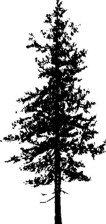|
SILVICS OF RED SPRUCE
(Picea rubens Sarg.)
Common names:
- yellow spruce, Maritime spruce
Field identification aids:
- bright yellow-green, blunt, four-cornered needles that can roll between your fingers (needles are usually longer than those on black spruce)
- reddish bark on young trees orange-brown and slightly hairy twigs
- Large broad crown, with right angled branches that curve upward near the ends
- red and black spruce interbreed and are often difficult to tell apart
Average mature tree:
- 80 to 100 years old
- 21 m to 26 m (70' to 86') tall
- 30 cm to 60 cm (12" to 24") in diameter at breast height
Maximum life span
- 200 - 400 years
Shade tolerance:
- very tolerant
Rooting:
- shallow and widespread
Windfirmness:
- only moderately windfirm on most Nova Scotian sites, susceptible to wind damage
Reproduction:
- reproduces by seed
- tree may begin to produce seed when 20 to 30 years old, with full crop production usually after 45 years
- good cone crops every 3 to 8 years
- best germination occurs on a moist mixture of mineral soil and humus
- poor germination on thick duff
Growing sites:
- range from well-drained to poorly drained
- best growth is on well -drained, acidic sandy soil
- usually found on moderately drained soils
Associated species:
- black spruce, balsam fir, tamarack, and red maple on poorly drained sites
- sugar maple, yellow birch, beech, and balsam fir on well drained sites
- often found in pure stands
Principle damaging agents:
- spruce budworm, spruce bark beetle, brown spruce longhorn beetle, porcupines
Notes:
- red spruce comprise 22.8% of the merchantable volume in Nova Scotia
- the most valuable lumber and pulpwood species in Nova Scotia
- Nova Scotia’s provincial tree
|


